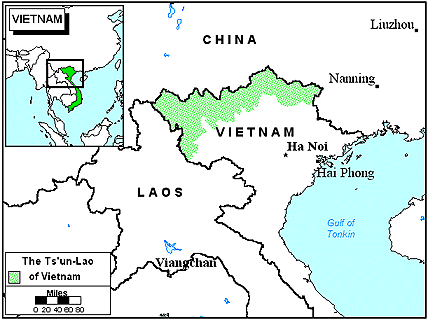|
|
Prayer Profile
The Tsun-Lao of Vietnam
![[IMAGE]](../images3/0581.jpg) The Tsun-Lao live in the mountainous regions of northern Vietnam, where Vietnamese influence was minimal until the 1900's. Today, however, many of them are assimilated into the Vietnamese culture. The Tsun-Lao are part of a larger cultural linguistic group of Tai peoples, which includes the Shan, the Laotians, and others. It is possible that the Tsun-Lao and the Lao are the same official ethnic community.
The Tsun-Lao live in the mountainous regions of northern Vietnam, where Vietnamese influence was minimal until the 1900's. Today, however, many of them are assimilated into the Vietnamese culture. The Tsun-Lao are part of a larger cultural linguistic group of Tai peoples, which includes the Shan, the Laotians, and others. It is possible that the Tsun-Lao and the Lao are the same official ethnic community.
Centuries ago, Lao lived in China. However, relentless pressure by the Chinese gradually forced them southward into Laos, Myanmar, Thailand, and Vietnam. In 1954, Communist rebels emerged in North Vietnam, and military regimes formed, leading to massive bloodshed. The war finally ended in a Communist victory in 1975, when the Communist Republic of North Vietnam overtook South Vietnam. Post-war North Vietnam has gone through a period of intense reconstruction of industry, yet there has been a deterioration in the quality of output.
What Are Their Lives Like
The Tsun-Lao are primarily rice farmers, although gathering forest products, fishing, hunting, breeding livestock, and making handicrafts are also important activities. The farmers grow wet rice on terraces watered by small brooks. They also raise dry rice on swiddens, or plots cleared by the "slash and burn" method. Since rice production is minimal, cinnamon and wood are gathered for trade.
The Tsun-Lao live in villages alongside rivers or near roads that give them access to Chinese merchants. Their houses are typically made of wood or bamboo and are built high on stilts. Poultry, pigs, and goats are allowed to run freely underneath the houses. The Buddhist Wat, or temple, is the center of village life.
In times past, social organization among the Tsun-Lao was aristocratic. Each village was led by a headman who had ultimate authority over the villagers. In 1945, the authority of headmen was abolished. Since that time, each community has been governed by a committee elected by the people's council. There is no longer a rigid social class system or a hereditary elite class. Modern Tsun-Lao social structure is based on family units, with no widespread lineages or clans.
Tsun-Lao culture has changed dramatically as a result of Vietnam's transition from a feudal to a socialist society. The farmers now belong to agricultural cooperatives and share equally in production. In addition, small-scale industrialization has helped turn agricultural peasants into a Vietnamese working class. Socialism has also brought improved education and health care. A medical school and some hospitals have been built in the Tsun-Lao region. These have helped gain control over diseases such as small pox, cholera, tuberculosis, and malaria.
What Are Their Belief?
Half of the Tsun-Lao are devout Theravada Buddhists. They believe that right thinking, ritual sacrifices, and self-denial will enable the soul to reach nirvana (a state of eternal bliss) at death. They live in fear of their gods and constantly strive to appease them with ritual chants and sacrifices.
The remaining Tsun-Lao are ethnic religionists, combining folk animism (belief that non-human objects have spirits) with Buddhism. They seek help through various supernatural beings and objects. Of major importance to them are the "territorial deities."
What Are Their Needs?
The Tsun-Lao have many physical needs. They occupy a region in which yearly monsoons destroy schools, clinics, and bridges and threaten to leave hundreds homeless. As recently as August, 1996, many people were killed, and thousands were left homeless in the severe storms, landslides, and flash flooding that occurred. Humanitarian aid, medical facilities, and doctors are needed in this region.
Spiritually, the needs of the Tsun-Lao are even greater. Those who have been affected by the fighting and bloodshed of the past are in desperate need of inner healing and true spiritual hope. Prayer is the key to seeing them reached with the Good News.
Prayer Points
- Ask the Lord to call medical missionaries and humanitarian aid workers to go to Vietnam and share Christ with the Tsun-Lao.
- Pray that the Lord will give the missions agency new strategies for effectively evangelizing the Tsun-Lao.
- Ask God to use the Tsun-Lao believers to share the love of Jesus with their own people.
- Pray that the Lord will begin revealing Himself to the Tsun-Lao through dreams and visions.
- Ask the Holy Spirit to anoint the Gospel as it goes forth via radio in this region.
- Pray that God will save key leaders among the Tsun-Lao who will boldly proclaim the Gospel.
- Take authority over the spiritual principalities and powers that are keeping the Tsun-Lao bound.
- Ask the Lord to raise up strong local churches among the Tsun-Lao.

See also the following related groups:
The Lao of
Cambodia,
Laos
and
Vietnam.
Statistics
Latest estimates from the World Evangelization Research Center.
THE PEOPLE
- People name: Tsun-Lao
- Country: Vietnam
- Their language: Tsun-lao
- Population:
- Largest religion:
- Christian: 1%
- Church members: 373
- Scriptures in their own language: None
- Jesus Film in their own language: None
- Christian broadcasts in their own language: None
- Mission agencies working among this people: 1
- Persons who have heard the Gospel: 7,500 (20%)
- Persons who have never heard the Gospel: 29,800
THEIR COUNTRY
- Country: Vietnam
- Population:
- Major peoples in size order:
- Major religions:
- Number of denominations: 20
© Copyright 1997
Bethany World Prayer Center
This profile may be copied and distributed without obtaining permission
as long as it is not altered, bound, published
or used for profit purposes.
![[HOME BUTTON]](../graphics/home.jpg)
![[CALENDAR BUTTON]](../graphics/calico.jpg)
![[LIST BUTTON]](../graphics/listico.jpg)
[Home]
[Calendar]
[Country List]
|